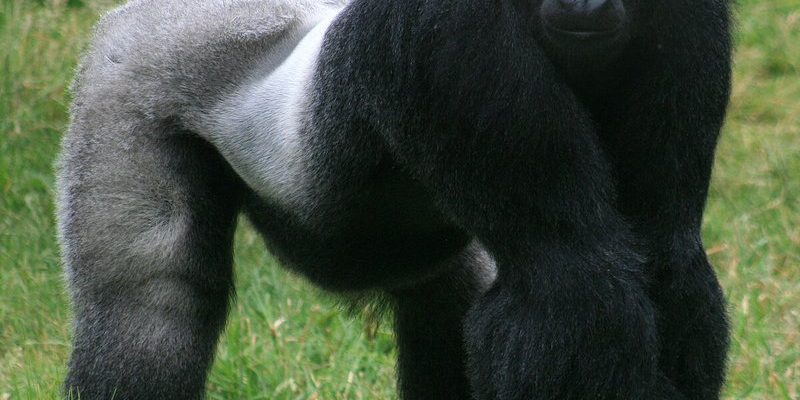![Comparing The Western Gorilla Vs. [Similar Species]](https://gudri.com/wp-content/uploads/2025/06/Comparing_The_Western_Gorilla_Vs___Similar_Species__image_0-1.jpg)
Imagine you’re at a zoo, watching these majestic creatures interact. The Western gorilla may seem a bit more sociable, while the Eastern gorilla embodies the strength and stoicism of its wild habitat. So, let’s dive into the world of these incredible animals and explore what sets them apart and what brings them together.
Physical Appearance: Size and Features
When we look at the **Western Gorilla**, one of the first things we notice is its robust body and striking features. Adult males, known as silverbacks, can weigh between 300 to 400 pounds, showcasing a broad chest and powerful limbs. Their fur is typically a dark black or brown, giving them a sleek appearance.
On the other hand, the **Eastern Gorilla**, which includes the Mountain gorilla and the Eastern Lowland gorilla, is slightly larger. Male Eastern gorillas can weigh over 450 pounds! They have a similar build, but their fur tends to be longer and shaggier, especially in the Mountain gorillas, which helps keep them warm in their cooler mountainous habitats. The differences in their fur and size help them survive in their specific environments, making them impressive animals in their own right.
Habitat and Range
Both gorilla species call Africa home, but their habitats are quite different. The **Western Gorilla** primarily resides in the dense rainforests of Central and West Africa, thriving in areas like the Congo Basin. They enjoy a warm, humid climate full of trees, vines, and a rich diversity of food sources.
In contrast, the **Eastern Gorilla** is found in the mountainous regions, particularly in the Virunga Mountains, which stretch across Rwanda, Uganda, and the Democratic Republic of Congo. This high-altitude environment is cooler, and the gorillas adapt by having thicker fur. Each species’ unique habitat plays a vital role in shaping their behaviors and lifestyles, from foraging for food to finding shelter.
Diet: What Do They Eat?
Gorillas are primarily herbivores, but their diets vary slightly between the two species. The **Western Gorilla** enjoys a varied diet, munching on fruits, leaves, stems, and occasionally flowers. Their foraging habits can affect their territory size, which can range from 10 to 20 square miles.
Meanwhile, the **Eastern Gorilla** has a more specialized diet, especially the Mountain gorillas, which thrive on a diet rich in leaves, shoots, and stems. Here’s an interesting fact: Mountain gorillas often eat the tough, fibrous vegetation found in their mountainous homes, which helps them maintain their impressive size. Both species play crucial roles in their ecosystems by helping to disperse seeds, promoting plant growth.
Social Structure: Family Dynamics
Gorilla social life is as intriguing as it gets. The **Western Gorilla** tends to be more social and forms smaller, more fluid groups. These groups may consist of a dominant silverback, a few females, and their offspring. Their interactions can be playful, with young gorillas often seen playing and wrestling, showcasing a playful side that humans can relate to.
In contrast, the **Eastern Gorilla** is often seen in larger, more stable groups. These groups may have several females but typically only one silverback. Stability is vital, as the silverback protects the family from outside threats. Watching them interact is like witnessing a close-knit family dynamic, where every member has its role, contributing to the overall harmony.
Conservation Status: Protecting the Gorillas
Sadly, both gorilla species face threats from habitat loss, poaching, and disease. The **Western Gorilla** is listed as Critically Endangered due to significant declines in their population. Deforestation for agriculture and logging has devastated their habitats, making it essential for conservation efforts to take action.
The **Eastern Gorilla** also suffers from similar threats and is classified as Endangered. Conservation efforts focus on protecting their habitats, enforcing anti-poaching laws, and educating local communities on the importance of gorillas in the ecosystem. By raising awareness and supporting these efforts, we can play a role in ensuring these majestic creatures survive for generations to come.
Unique Behaviors: Communication and Interaction
Gorillas are known for their intelligence and complex social behavior. The **Western Gorilla** is often more expressive, using a wide range of vocalizations—from grunts to hoots—to communicate with their group. They also exhibit playful behaviors, showing curiosity and intelligence that is fascinating to observe.
On the flip side, the **Eastern Gorilla** tends to be a bit more reserved. While they also communicate through vocalizations and body language, their calm demeanor often makes them appear stoic. This difference in behavior reflects not only their personalities but also their environments. The more sociable nature of the Western gorilla suits its lush surroundings, while the Eastern gorilla’s reserved traits help it navigate its more challenging habitat.
In conclusion, comparing the **Western Gorilla** and the **Eastern Gorilla** reveals a rich tapestry of diversity in the animal kingdom. While they share common ancestry and many traits, their differences in physical appearance, habitat, diet, and social structures paint a fascinating picture of adaptation and survival.
As you think about these incredible creatures, remember that they play a vital role in our world, reminding us of the importance of conservation. By learning more about the **Western** and **Eastern gorillas**, we can appreciate their unique qualities while supporting efforts to protect them. After all, it’s our shared responsibility to ensure that these magnificent animals continue to roam the earth and inspire wonder for generations to come.

